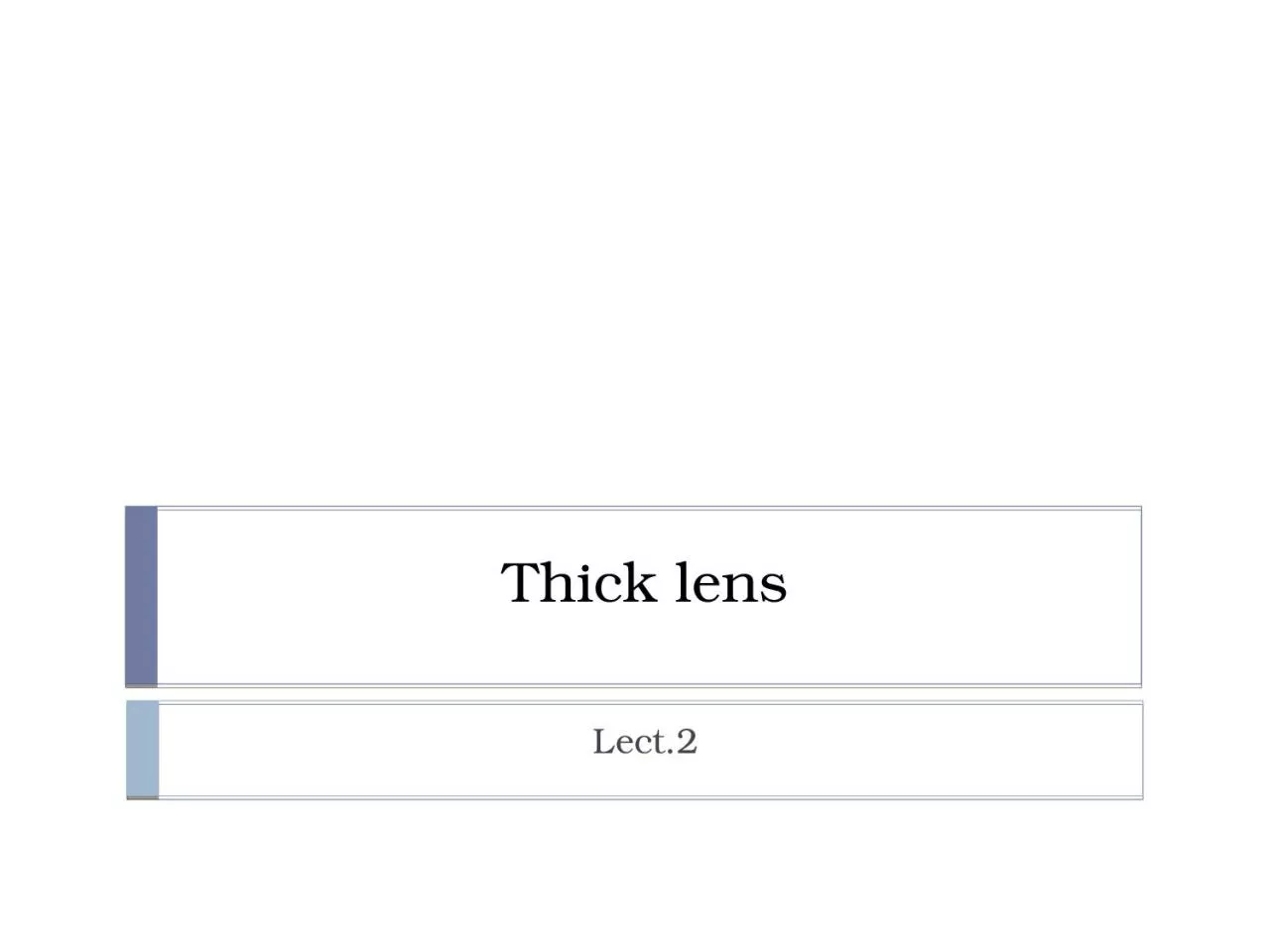

formed by a thick lens and then apply the general formulas already given for calculating image distances The formulas to be used are We shall first consider the parallelray method for graphically locating ID: 929633
Download Presentation The PPT/PDF document "Thick lens Lect.2 TWO SPHERICAL SURFACES" is the property of its rightful owner. Permission is granted to download and print the materials on this web site for personal, non-commercial use only, and to display it on your personal computer provided you do not modify the materials and that you retain all copyright notices contained in the materials. By downloading content from our website, you accept the terms of this agreement.
Slide1
Thick lens
Lect.2
Slide2TWO SPHERICAL SURFACES
formed by a thick lens and then apply the general
formulas already given for calculating image distances. The formulas to be used are
Slide3We shall first consider the parallel-ray method for graphically locating
an image formed
by a thick lens and then apply the general formulas already given for calculating image distances. The formulas to be used are :
Slide4The parallel-ray method of graphical construction, applied to a thick lens of two
surfaces, is shown in Fig. 5B. Although the diagram is usually drawn as one, it has
been separated into two parts here to simplify its explanation. The points
F1 and F1’represent the primary and secondary focal points of the first surface, and F2' and F2’’represent the primary and secondary focal points of the second surface, respectively.
Slide5EXAMPLE
I An
equiconvex
lens 2 cm thick and having radii of curvature of 2 cm is
mounted in the end of a water tank. An object
in
air
is placed on the axis of
the lens 5 cm from its vertex. Find the position of the final image. Assume refractive indices of 1.00, 1.50, and 1.33 for air, glass, and water, respectively
SOLUTION The relative dimensions in this problem are approximately those
shown in Fig. 5B(b). If we apply Eq. (Sa) to the first surface alone, we find the
image distance
to be
Slide6Slide7When the same equation is applied to the second surface, we note that the
object
distance
is s;' minus the lens thickness, or 28 cm, and that since it pertains
to a virtual
object it has a negative sign. The substitutions to be made are,
therefore, S2
= -28
em
, n' = 1.50, n" = 1.33, and r2 = -2.0 cm.
Slide8The incident rays in the glass belong to an object point M', which is
virtual, and thus S2, being to the right of the vertex A2, must also be negative. The
final image is formed in the water (n" = 1.33) at a distance +9.6 cm from the second
vertex. The positive sign of the resultant signifies that the image is real.It should be noted that
Eqs
. (Sa) hold for paraxial rays only. The diagrams in
Fig. 5B, showing all refraction as taking place at vertical lines through the vertices
Ai and A2, are likewise restricted to paraxial rays.
Slide9Diagrams showing the characteristics of the two focal points of a thick lens are given
in Fig. 5C.
Transverse
planes through
these intersections constitute primary and secondary principal planes.
These planes
cross the axis at points Hand H", called the principal points.
Slide10If the media on the two sides of the lens are different so that n" is not equal to n,
the two focal lengths are different and have the ratio of their corresponding
refractive indices
:
In general the focal points and principal points are not symmetrically located
with respect to the lens but are at different distances from the vertices.
he construction procedure follows that given in Fig. 4M for a
thin lens, except that here all rays in the region between the two principal planes
are drawn
parallel to the axis.
the object and image distances are measured to
or from
the principal points, we can apply the
gaussian
lens formula
Slide11In the special case where the media on the two sides of the lens are the same, so
that n" = n, we find!" = land Eq. (5c) becomes
Figure 5F shows that for the purposes of graphical construction the lens may
be regarded as replaced by its two principal planes. Often the image distance is the
unknown, and Eq. (5c) can be written in the more useful form
CONJUGATE RELATIONS
Slide12Slide13Slide14THE OBLIQUE-RAY METHOD
The oblique-ray method of construction may be used to find graphically the focal
points of a thick lens. As an illustration, consider a glass lens of index 1.50, thickness
2.0 cm, and radii T1 = +3.0 cm, T2
= -5.0
cm
, surrounded by air of index n = 1.00.
Slide15Slide16A set of formulas that can be used for the calculation of important constants generally
associated with a thick lens is presented below in the form of two equivalent sets.
Slide17These equations are derived from geometrical relations that can be obtained from a
diagram like Fig. 5G. As an illustration, the
gaussian
equation (5k) is derived asfollows. From the two similar right triangles T1A1F1’and T2A2F2’’ we can writecorresponding sides as proportions
and, from the two similar right triangles N"H"F" and T2A2F", we can write the
proportions
the neutralizing power.
Pn
=
Calling
Pn
the neutralizing power, we can take
the reciprocal of Eq. (5h) to obtain
Slide18Slide19EXAMPLE 2 A lens has the following specifications: r1 = + 1.5 cm, r2
= .
+ 1.5 cm, d = 2.0 cm, n = 1.00, n' = 1.60, and n" = 1.30. Find (a) the
primary and
secondary focal lengths of the separate surfaces, (b) the primary and
secondary focal
lengths of the system, and (c) the primary and secondary principal points
.
SOLUTION (a) To apply the
gaussian
formulas, we first calculate the individual
focal lengths of the surfaces by means of Eq. (5f).
Slide20